
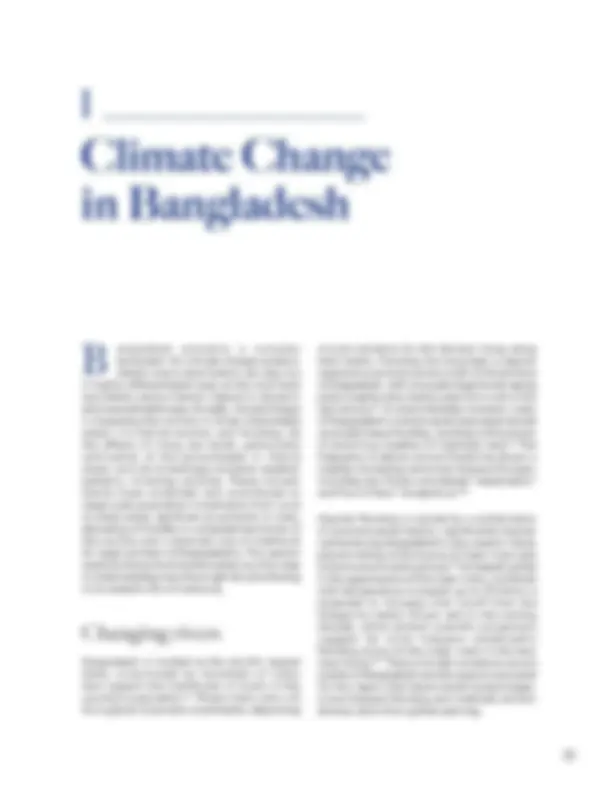
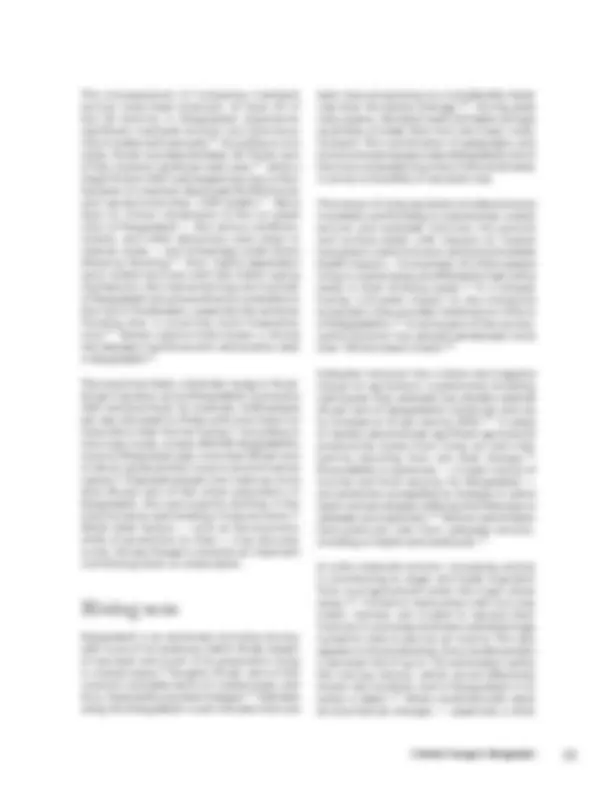
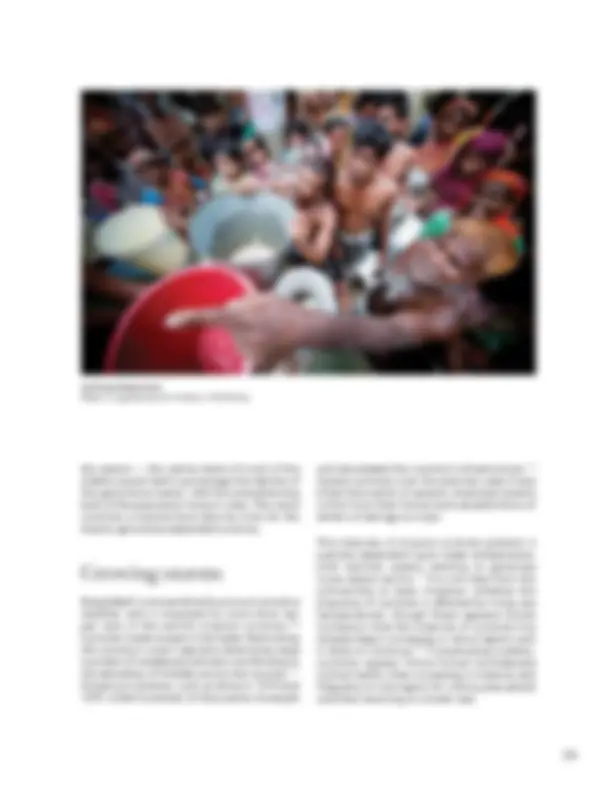
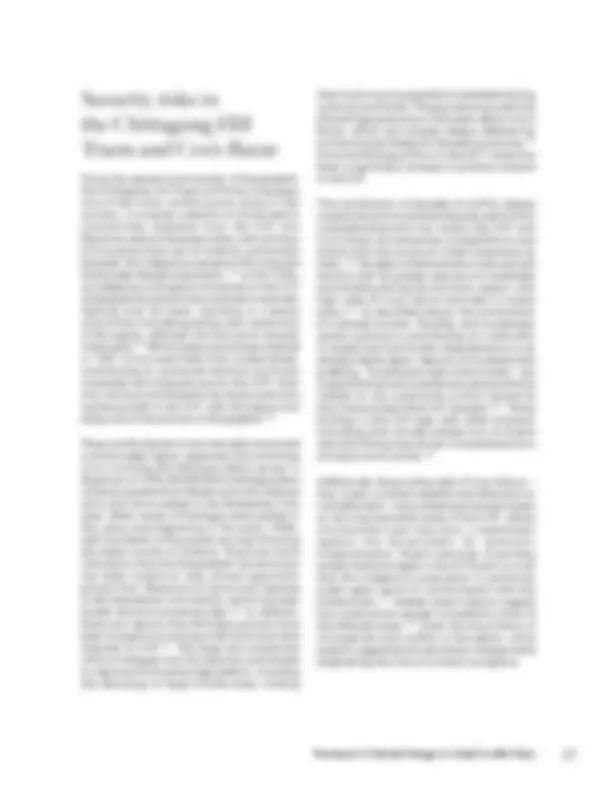
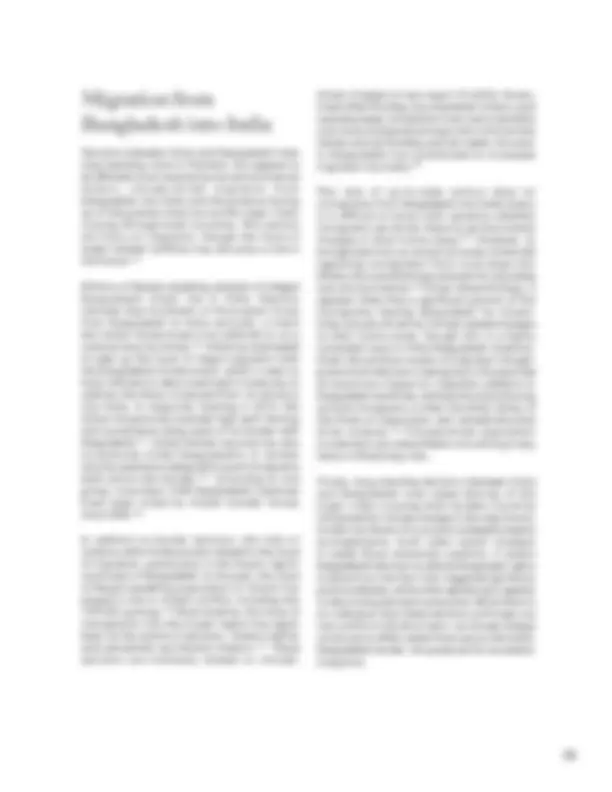
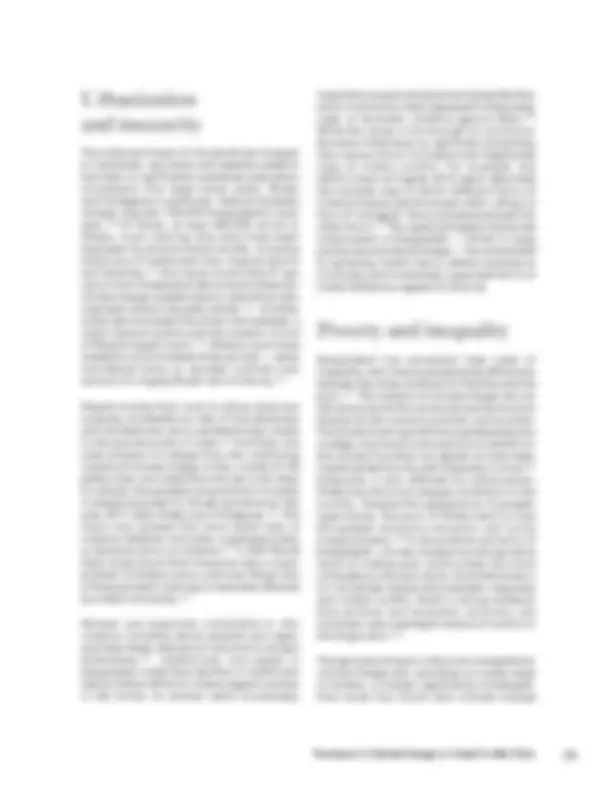
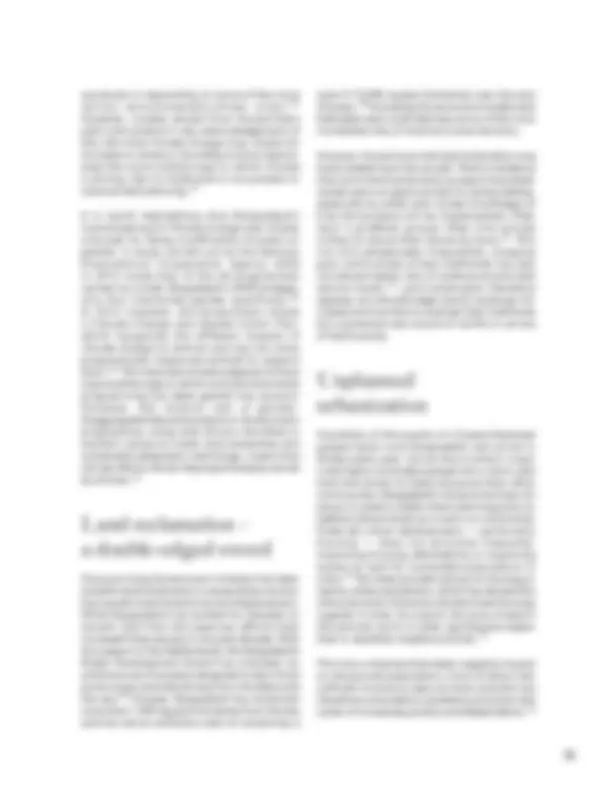
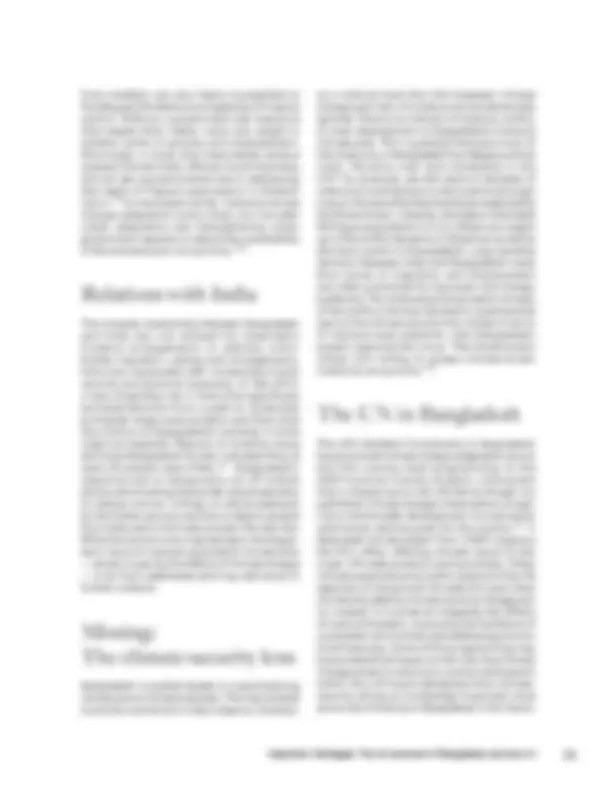
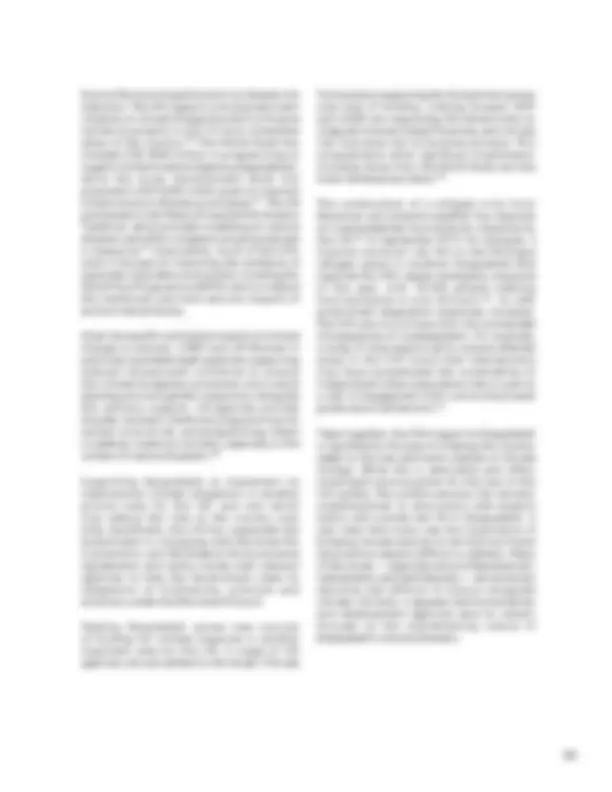
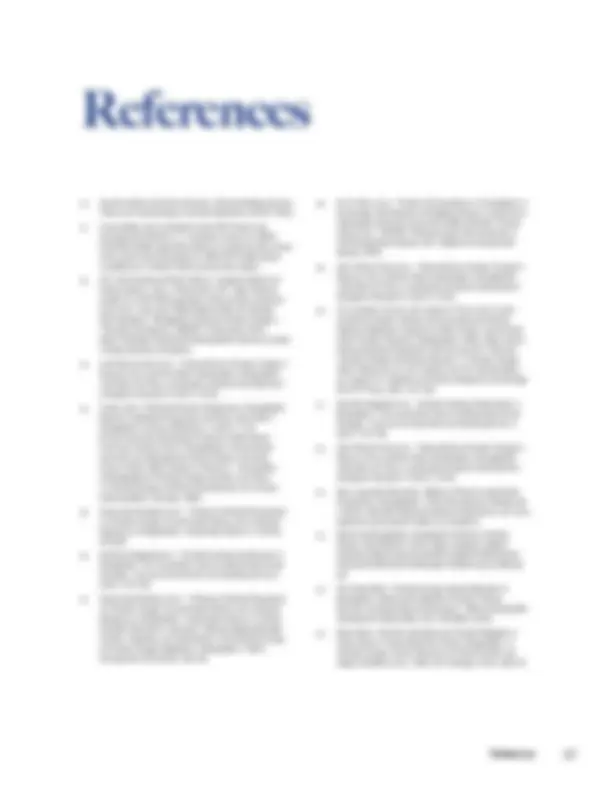

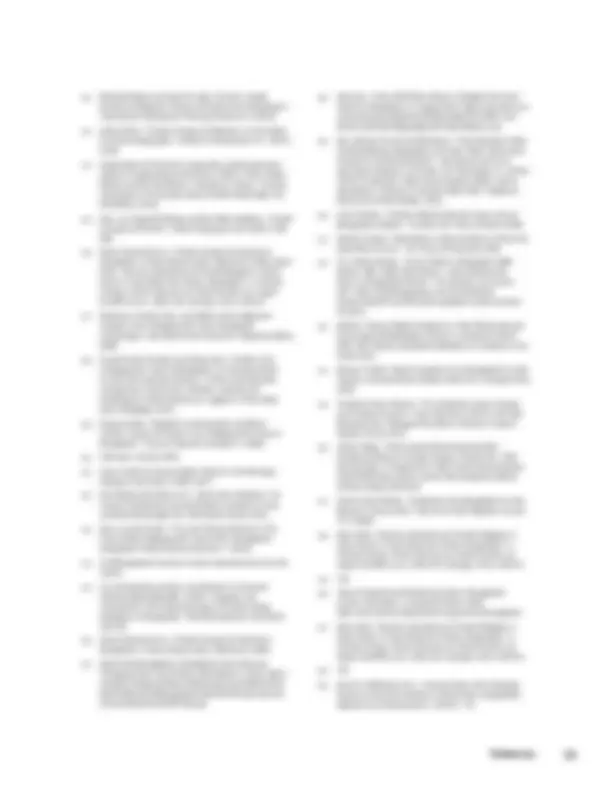
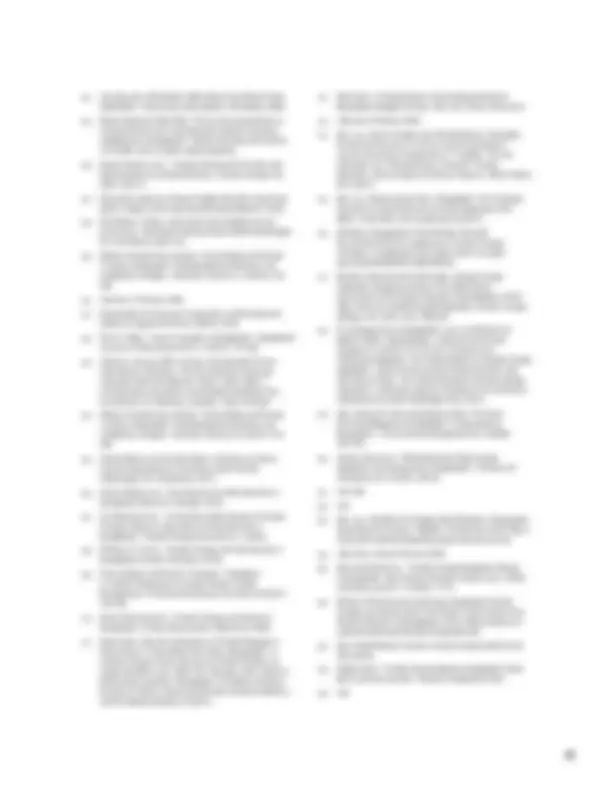
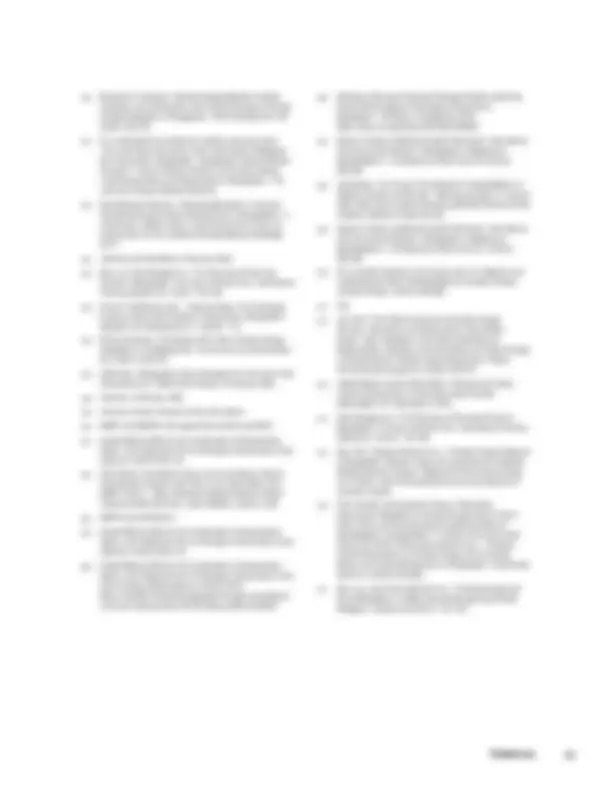


Study with the several resources on Docsity

Earn points by helping other students or get them with a premium plan


Prepare for your exams
Study with the several resources on Docsity

Earn points to download
Earn points by helping other students or get them with a premium plan
Community
Ask the community for help and clear up your study doubts
Discover the best universities in your country according to Docsity users
Free resources
Download our free guides on studying techniques, anxiety management strategies, and thesis advice from Docsity tutors
The vulnerability of Bangladesh to climate change, focusing on the impacts on livelihoods, environmental stress, and security. research articles, reports, and studies that discuss the effects of climate change on various sectors, such as agriculture, water resources, and urban areas. The document also highlights the need for institutional response and policy intervention to mitigate the impacts of climate change and ensure livelihood resilience.
Typology: Study notes
1 / 22

This page cannot be seen from the preview
Don't miss anything!















Case 1
UN Photo/Kibae Park
ocated in the world’s largest river delta, Bangladesh’s fertile territory and coastal waters sustain an extraordinarily dense and fast-growing population. With a majority of Bangladeshis living in coastal and riverine areas, and a heavy dependency on fragile agricultural crops, it is also one of the most vulnerable countries to environmental shocks.
Here, climate change is already having an unmistakable impact. Rising temperatures have dramatically increased annual river flooding, displacing hundreds of thousands of Bangladeshis every year; higher sea levels are causing greater saline content in the groundwater; increasingly severe tropical cyclones have damaged arable land and exacerbated inland inundation; and more erratic rainfall has meant the agricultural sector has swung between droughts and floods. Facing the certainty of continued temperature rises globally, and already feeling the impact of regional tensions, Bangladesh’s Prime Minister has called climate change an “existential threat” to her country.^82
This case study explores the extent to which climate change may be impacting the risks of violence and insecurity in
Bangladesh. Examining the major trends and scientific findings on environmental changes across the country, it investigates the extent to which those changes may be exacerbating underlying tensions, creating new disputes over resources or increasing the resort to violence in particular communities. The study also examines the Government’s attempts to adapt to climate change in Bangladesh, asking how State-led adaptation efforts may have mitigated conflict risks. Drawing on interviews with in-country experts, the study describes the UN’s strategy for supporting climate adaptation in Bangladesh, focusing on efforts that reduce risks of violence. The analysis suggests that the UN’s prevention challenge in Bangladesh is intimately related to climate change, requiring tailored strategies to support inclusive and sustainable governance responses in the face of rapidly escalating environmental risks.
The study proceeds in four parts: (1) the impact of climate change on Bangladesh; (2) how climate-related changes are affecting the risks of violent conflict; (3) the response by the Government and the UN; and (4) lessons and recommendations.
L
The consequences of increasing riverbank erosion have been dramatic. At least 20 of the 64 districts in Bangladesh experience significant riverbank erosion and enormous loss of arable land annually.^89 According to one study, floods inundate between 20-70 per cent of the country’s landmass each year, 90 while a single flood in 2007 submerged over two million hectares of cropland, destroyed 85,000 homes and caused more than 1,000 deaths. 91 More than six million inhabitants of the so-called chars of Bangladesh — the various sandbars, islands, and other temporary land areas in riparian zones — are increasingly under direct threat by flooding.^92 Poor, highly dependent upon arable land and with few viable coping mechanisms, the riverine farming communities of Bangladesh are extraordinarily vulnerable to the rise of floodwaters, especially the extreme flooding that is occurring more frequently now. 93 Recent reports have drawn a strong link between riverine erosion and poverty rates in Bangladesh.^94
The result has been a dramatic surge in flood- driven migration across Bangladesh. During the 2007 extreme flood, for example, 3,000 people per day relocated to Dhaka and most have not returned to their former homes. 95 According to one major study, at least 400,000 Bangladeshis move to Dhaka each year, more than 80 per cent of whom attribute their move to environmental causes. 96 Displaced people now make up more than 80 per cent of the urban population of Bangladesh, the vast majority working in the informal sector and residing in insecure slums.^97 While other factors — such as the economic shifts of production to cities — may also play a role, climate change is certainly an important contributing factor to urbanization.
Rising seas
Bangladesh is an extremely low-lying country with most of its landmass within three meters of sea level and much of its population living in coastal areas. 98 Roughly 30 per cent of the country’s cultivable land is in coastal areas, and thus, impacted by sea level changes.^99 Tidal data along the Bangladeshi coast indicates that sea
level rises are growing at a considerably faster rate than the global average. 100 During peak rainy season, sea levels swell still higher as huge quantities of water flow from the major rivers outward. This combination of geography and environmental change makes Bangladesh one of the most vulnerable countries in the world when it comes to the effect of sea level rises.
The impact of rising sea levels includes extreme inundation and flooding in coastal areas, coastal erosion and saltwater intrusion into ground and surface water, with impacts on coastal ecosystems. Saline intrusion can have immediate health impacts — for example, 20 million people living in coastal areas are affected by high saline levels in their drinking water. 101 It is already having a broader impact on the mangrove ecosystems that provides livelihood to millions of Bangladeshis.^102 In some parts of the country, saline intrusion has already penetrated more than 100 kilometers inland.^103
Saltwater intrusion has a direct and negative impact on agriculture, a particularly troubling trend given that saltwater has already reached 26 per cent of Bangladesh’s landmass and set to increase to 55 per cent by 2050. 104 A range of studies demonstrate significant agricultural productivity losses from rising soil and river salinity resulting from sea level change. 105 Rice paddies in particular — a major source of income and food security for Bangladesh — are extremely susceptible to changes in saline levels and are already suffering shortfalls due to saltwater encroachment.^106 Women and children face particular risks from saltwater erosion, including to health and livelihoods.^107
As with riverbank erosion, increasing salinity is contributing to larger and faster migration from rural agricultural zones into major urban areas. 108 Forced to leave areas with low crop yields, farmers are unable to replace their incomes in rural areas and have overwhelmingly turned to cities to eke out an income. This also appears to be accelerating. Some studies predict a sea level rise of up to 125 centimeters within the coming century, which would effectively drown the southern half of Bangladesh if no action is taken. 109 When combined with other environmental changes — especially a drier
dry season — the salinity levels of much of the arable coastal land may presage the decline of the agricultural sector, with the overwhelming bulk of the population living in cities. The result could be a massive food security crisis for the heavily agriculture-dependent country.
Growing storms
Bangladesh is extraordinarily prone to extreme weather and is impacted by more than ten per cent of the world’s tropical cyclones. 110 Cyclones create surges in the water levels along the country’s coast, regularly destroying large numbers of residences and also contributing to the denuding of hillsides across the country.^111 Disastrous cyclones, such as those in 1970 and 1991, killed hundreds of thousands of people
and devastated the country’s infrastructure.^112 Severe cyclones over the past ten years have killed thousands of people, displaced several million from their homes and caused billions of dollars of damage to crops.
The intensity of tropical cyclones globally is partially dependent upon water temperature, with warmer waters tending to generate more severe storms. 113 It is not clear from the scholarship to date, however, whether the frequency of cyclones is affected by rising sea temperatures, though there appears broad consensus that the intensity of cyclones has already begun increasing in some regions and is likely to continue. 114 Complicating matters, cyclones appear follow broad multidecade cyclical trends, often increasing in intensity and frequency in one region for a thirty year period and then returning to a lower rate.
UN Photo/Kibae Park Water is supplied by the military in Old Dhaka.
nalysing the impact of climate change on the risks of violence in Bangladesh is complex. As other studies on climate- security have identified, often the relationship between environmental change and other dynamics is indirect and combined with a range of other contributing factors. Even the concept of security can be confusing — there is a tendency to conflate the notion of “human security” with the more specific issue of violent conflict, and also to assume that poor development leads inexorably towards greater conflict risks. This report recognizes the research findings about the linkages between poor human security and higher risks of violent conflict, particularly where socioeconomic grievances are based on high levels of inequality. 124 But it also acknowledges the shortcomings of the (often implicit) assumption that poor socioeconomic development, resource scarcity and related migration will drive people towards more violent modes of behaviour.^125
The analysis in this report concludes that in many areas climate change is acting as a “threat multiplier,” exacerbating existing tensions and increasing the likelihood that individuals and communities resort to violence, including: (1) increasing security risks in the Chittagong
Hill Tracts and Cox’s Bazar refugee camps; (2) heightening tensions along the India-Bangladesh border and within India; and (3) causing rapid and potentially dangerous urbanization. In addition, climate change is having: (4) a significant effect on the socioeconomic development of a country that already suffers from high levels of inequality, where the shocks of crop shortages and natural disasters are disproportionately felt by the poorest and most marginalized. These findings align with and amplify existing studies on climate-security in Bangladesh 126 and also contributes to the literature on the ways in which climate change is multiplying risks elsewhere in the world, including by increasing competition over scarce resources, increasing population movements and reducing key livelihoods that prevent individuals from more violent forms of survival.
A
II
The Impact of Climate
Change on Violent
Conflict Risks
In many areas climate change
is acting as a “threat multiplier,”
exacerbating existing
tensions and increasing the
likelihood that individuals and
communities resort to violence.
Security risks in
the Chittagong Hill
Tracts and Cox’s Bazar
Along the easternmost border of Bangladesh, the Chittagong Hill Tracts (CHT) has long been one of the most conflict prone areas of the country. A complex network of mixed ethnic communities stretches from the CHT into Myanmar and northeastern India, with a history of occasional flare ups of violence, particularly between the indigenous people of the area and the broader Bengali population.^127 In the 1970s, an indigenous insurgency movement in the CHT challenged the Government and led to sporadic fighting over 20 years, resulting in a peace accord that included granting semi-autonomy to the region, although this has yet to actually materialize.^128 While a peace accord was reached in 1997, it has never been fully implemented, contributing to continued tensions and hotly contested land disputes across the CHT. Over time, this has contributed to far slower and more uneven growth in the CHT, with the region now being one of the poorest in Bangladesh.^129
These conflict dynamics are intimately connected to the broader region, especially the continuing crisis involving the Rohingya ethnic group in Myanmar. In 1978, 250,000 ethnic Rohingya were violently expelled from Myanmar by the national army and some settled in the Bandarban Hills area. Other waves of Rohingya were settled in the same area beginning in the early 1990s, with hundreds of thousands arriving following the latest rounds of violence. There are some indications that the Bangladeshi Government has been unable to stop armed opposition groups from Myanmar to recruit and operate in the Bandarban Hills District, which has kept border tensions extremely high. 130 In addition, there are reports that Rohingya groups have been brought into existing intercommunal land disputes in CHT. 131 The large and unplanned influx of refugees into the area has contributed to rapid environmental degradation, including the denuding of large hillside areas, making
them even more susceptible to landslides during cyclones and floods. The population growth has placed huge pressure on the water table in Cox’s Bazar, which was already deeply affected by environmental change for decades previously.^132 Since the Rohingya influx in late 2017, there has been a significant increase in political violence in the CHT.
The combination of decades of conflict, deeply rooted intercommunal land disputes and chronic underdevelopment has meant the CHT and Cox’s Bazar are extremely susceptible to new shocks and also prone to violent responses to them. 133 Decades of deforestation have also left the hills with far greater exposure to landslides and flooding during the monsoon season, with high rates of crop failure recorded in recent years. 134 As described above, the combination of riverbank erosion, flooding, and increasingly severe cyclones is contributing to a reduction of arable land and further displacements in an already fragile region. Reports of increased land grabbing – including through violent means – are a signal that tensions have grown and are directly related to the underlying conflict dynamics that have existed there for decades. 135 These findings in the CHT align with other research indicating that climate-related loss of arable land and fishing have driven increased tensions amongst communities.^136
Additionally, the growing rates of crop failure — due, in part, to severe weather and reductions in cultivable land — have a disproportionate impact on the impoverished areas of the CHT, where communities have long born a resentment against the Government for economic marginalization. Expert warnings of growing severe food shortages in the CHT point to a risk that the indigenous population in particular might again resort to confrontation with the Government. 137 Indeed, recent reports suggest that violence has already increased in some of the affected areas.^138 Given the long history of insurgencies and conflict in the region, some experts suggested climate-driven changes were heightening the risks of a future insurgency.
Urbanization
and insecurity
The collective impact of climate-driven changes to riverbanks, sea levels and weather patterns has been to significantly accelerate population movements into large urban areas, Dhaka and Chittagong in particular. Natural disasters already displace 700,000 Bangladeshis each year. 150 Of these, at least 400,000 arrive to Dhaka, most claiming that they have been displaced by environmental shocks, including direct loss of livelihoods from tropical storms and flooding.^151 One study found that 81 per cent of slum inhabitants had moved to Dhaka for climate change-related reasons, even those who migrated several decades earlier. 152 Another study demonstrated the direct link between a major tropical cyclone and the creation of one of Dhaka’s largest slums. 153 Dhaka’s slums have swelled to accommodate these arrivals — areas considered slums or squatter colonies now account for roughly 80 per cent of the city.^154
People moving from rural to urban areas are uniquely susceptible to risks of homelessness and landlessness and overwhelmingly reside in the poorest parts of cities. 155 Ironically, the cities present no refuge from the continuing impacts of climate change. In fact, a study of 136 global cities concluded that the two most likely to witness the greatest proportional increase in people exposed to climate extremes by the year 2017 were Dhaka and Chittagong. 156 The slums also present the most acute risks of violence, whether criminality, organized cartels or domestic forms of violence. 157 A 2007 World Bank study found that insecurity was a major problem in Dhaka’s slums, with over 90 per cent of the population claiming to have been affected by violent criminality. 158
Women are especially vulnerable to this violence, including sexual assaults and rapes, and have fewer avenues of recourse to protect themselves. 159 Additionally, one expert in Bangladesh noted that declines in livelihoods had an indirect effect on violence against women in the home. As women were increasingly
required to acquire employment alongside their work in the home, there appeared to be greater rates of domestic violence against them. 160 While this study is not focused on criminal or domestic violence per se , significant scholarship links various forms of violence with heightened risks of violent conflict. For example, the OECD’s States of Fragility 2016 report described the complex ways in which different forms of violence interact and drive each other, calling it a form of “contagion” that could easily spread into other forms.^161 The rapid and largely unplanned urbanization in Bangladesh — driven in large part by environmental change — has contributed to sprawling violent slums, where resorting to criminality and increasingly organized forms of violent behaviour appear on the rise.
Poverty and inequality
Bangladesh has extremely high rates of inequality, with massive and growing differences between the living conditions of the elite and the poor. 162 The impacts of climate change are not felt evenly across the country but are borne most directly by the country’s poorest communities. The Government’s growth-focused development strategy may have a macroeconomic benefit on the country but does not appear to have been implemented thus far with inequality in mind.^163 Inequality is also affected by urbanization: Dhaka has the most unequal conditions in the country. Despite the appearance of greater opportunity, the poor of Dhaka tend to face the greater economic exclusion and social marginalization. 164 In the political economy of Bangladesh, climate change has the perverse result of making poor communities still more vulnerable to the next shock. And while there is no immediate relationship between inequality and violent conflict, there is strong evidence that political and economic exclusion are consistent and meaningful drivers of conflict in the longer term.^165
The agricultural sector is the most susceptible to climate change and, according to a wide range of studies, is already significantly challenged. One study has found that climate change
causes significant and rapidly increasing losses in the rice production sector, which currently accounts for over 90 per cent of Bangladesh’s food production.^166 This can lead to precipitous shortfalls, such as in 2007 when a cyclone destroyed one million tons of rice and 350, trees. 167 Annually, climate variability reduces crop production by more than 7 per cent, a USD $26 billion loss that is experienced most directly by local farmers.^168 Beyond the economic impact, there is some evidence that changing rainfall patterns resulted in increased conflicts over water management for agriculture and fishing.^169
Competition over land is another area of concern. The poorest people often live on government-owned land, which is provided for free. As these lands are eroded by climate change and combined with the displacement of hundreds of thousands of people per year due to flooding, competition over the free land has grown increasingly fierce. In some districts, overcrowding on government-owned land has resulted in open violence, while there are also reports of violent land grabbing in areas where migrants had relocated. 170
Some scholarship has suggested that growing poverty and social marginalization may be driving recruitment into violent extremism, including jihadi groups with networks stretching into Afghanistan and beyond.^171 Violent attacks in 2015, reportedly by a group affiliated with Al Qaeda^172 and in 2016 by an Islamic State-aligned group, has kept the issue very much alive in Bangladesh. Recruitment into violent extremist groups is, according to some researchers, driven by socioeconomic inequalities that have been
exacerbated by climate-driven changes to livelihoods.^173 However, as significant scholarship has demonstrated, it should not be taken for granted that simple causal lines between poverty and violent extremism are difficult to draw, 174 Experts on Bangladesh consulted for this study have stressed that the dynamics around violent extremist groups in-country are far more politically influenced than related to socioeconomic conditions. But there is a perception amongst some quarters that the risk of violent extremism in Bangladesh may have grown in recent years. 175
Conclusion
There is a growing body of evidence to indicate that climate-driven changes in Bangladesh are contributing to greater risks of insecurity. The causal path is often not direct, but there is a strong case to be made that the increasingly severe and erratic weather patterns in Bangladesh have converged with existing risks in ways that have amplified the likelihood of violent conflict and in some cases contributed to violent deaths already. As the following section describes, the Government’s response to emerging dynamics is crucial, in particular how national and local programming may mitigate (or indeed unintentionally increase) risks. Examining both the national Bangladeshi adaptation strategy and the UN’s response, good practice and comparative lessons for the UN and partners are considered.
successes in responding to some of the most serious environmentally-driven crises. 183 However, notably absent from Government plans and analysis is any acknowledgement of the risks that climate change may create for increases in violence. According to some experts, even the more indirect ways in which climate is driving risks to livelihoods is not present in national level planning.^184
It is worth highlighting that Bangladesh’s mainstreaming of climate change was initially criticized for being insufficiently focused on gender. A study carried out by the German International Cooperation Agency (GIZ) in 2012 noted that of the 44 programmes carried out under Bangladesh’s 2008 strategy, only four mentioned gender specifically. 185 In 2013, however, the Government issued a Climate Change and Gender Action Plan, which recognizes the different impacts of climate change on women and lays out some programmatic responses tailored to support them.^186 This important initiative appears to have improved the ways in which some environmental programming has taken gender into account. However, the relative lack of gender- disaggregated data and analysis in Government programmes, along with chronic shortfalls in women’s access to credit, land ownership and sustainable adaptation technology, means that climate effects remain disproportionately carried by women.^187
Land reclamation –
a double-edged sword
One promising Government initiative has been towards land reclamation in areas where erosion has caused massive land loss and displacement. While Bangladesh has worked for decades to reclaim land from the seacoast, efforts have increased dramatically in the past decade. With the support of the Netherlands, the Bangladeshi Water Development Board has overseen an ambitious set of projects designed to dam flood prone areas and rebuild land into the delta and the sea. 188 Already, Bangladesh has reclaimed more than 1,000 square kilometres from the sea and has set an ambitious plan of reclaiming a
total of 10,000 square kilometres over the next 20 years.^189 Increasing the amounts of arable and habitable land could alleviate some of the most immediate risks of intercommunal tensions.
However, Government-led land reclamation may have created new risks as well. There is evidence that some land reclamation projects have been seized upon as opportunities for land grabbing, especially by elites with insider knowledge of how the projects will be implemented. After land is grabbed, groups often hire private militias to secure their tenure by force. 190 This not only perpetuates inequalities, stripping poor communities of their livelihoods, but also introduces higher risks of violence around land tenure issues. 191 Land reclamation therefore appears as a double-edge sword: necessary for coastal communities to maintain their livelihoods but a potential new source of conflict in an era of land scarcity.
Unplanned
urbanization
Hundreds of thousands of climate-displaced people leave rural Bangladesh and arrive in Dhaka every year. Across the country’s major cities highly vulnerable people live in slums and have less access to State resources than other communities. Bangladesh’s Government has not yet put in place a viable urban planning policy to address these trends at a macro or a local level. State-led urban development — particularly housing — does not prioritize inequality, improving housing affordability or improving access to land for vulnerable populations in cities.^192 The State provides almost no housing or land to urban populations, which has allowed the informal sector to become the dominant housing supplier in cities. As a result, the costs of land in the poorest slums is often significantly higher than in wealthier neighbourhoods.^193
This has a disproportionately negative impact on the poorest populations, most of whom lack sufficient income to take out loans and who are therefore vulnerable to predatory practices and cycles of increasing poverty and dependence.^194
Slum dwellers are also highly susceptible to flooding and the destructive capacities of tropical storms. Without a government-led response that targets their needs, many are caught in endless cycles of poverty and displacement. Worryingly, a study that interviewed several relevant Government officials found that they did not see a governmental role in addressing the needs of migrant populations in Dhaka’s slums. 195 As one expert wrote, “national climate change adaptation policy does not consider urban adaptation and strengthening urban government capacity to reduce the vulnerability of the extreme poor as a priority.”^196
Relations with India
The complex relationship between Bangladesh and India has not allowed for meaningful bilateral arrangements to address cross- border migration. Lacking such arrangements, India has responded with increasingly harsh security and political measures. In late 2019, a new citizenship law in India that specifically excluded Muslims from a path to citizenship prompted large-scale protests and fears that the millions of Bangladeshis residing in India might be expelled. Reports of violence along the India-Bangladesh border indicated that at least 20 people were killed. 197 Bangladesh’s response was to temporarily cut off mobile phone service along the border area (ostensibly to reduce rumour milling), to refuse attempts by the Indian security services to deport people from India and to formally protest the new law. While the current crisis may well pass, the longer- term issue of massive population movements — driven in part by the effects of climate change — is far from addressed and may well result in further violence.
Missing:
The climate-security lens
Bangladesh is a global leader in mainstreaming climate across its national plans. This has resulted in positive outcomes in many respects. However,
at a national level the links between climate change and risks of violence are fundamentally ignored. There is no mention of violence, conflict, or even displacement in Bangladesh’s national climate plan. This is partially because much of the insecurity in Bangladesh has deeply political roots. Tensions over land ownership in the CHT, for example, are the result of decades of intercommunal dynamics and a sense amongst many in the area that they have been neglected by the Government. Likewise, the highly vulnerable Rohingya populations in Cox’s Bazar are caught up in the conflict dynamics in Myanmar as well as domestic politics in Bangladesh. Long-standing tensions between India and Bangladesh mean that issues of migration and displacement are often politicized for domestic and foreign audiences. The intensely political nature of many of the conflict risks has resulted in a partial blind spot on the climate-security link, at least in terms of national level attention. One Bangladeshi expert captured the issue, “The Government simply isn’t willing to accept climate-driven insecurity as a priority.” 198
The UN in Bangladesh
The UN’s Resident Coordinator in Bangladesh has prioritized climate change adaptation across the UN’s country level programming. In the 2020 Common Country Analysis, a document that is shared across the UN family though not published, climate change is featured as a major risk to the broader development, humanitarian and human security goals for the country.^199 A dedicated climate expert from UNDP supports the RC’s office, offering climate inputs to the major UN-wide products and processes. Other climate expertise exists within several of the UN agencies on the ground. Broadly this work does not directly address climate-security linkages per se ; instead, it is aimed at mitigating the effects of natural disasters, improving the resilience of vulnerable communities and addressing chronic food insecurity. Some of this programming may have a beneficial impact on the risks that climate change poses to security in-country and experts within the UN have highlighted that climate- security will be an increasingly important issue across the UN family in Bangladesh in the future.
Think beyond climate change as a threat multiplier.
The term “threat multiplier” usefully positions climate change as one of many factors influencing security risks in a given setting, and it avoids the kind of deterministic causality that has caused concern amongst scholars. However, as the Bangladesh case highlights, merely thinking of climate as multiplier may fail to capture the scope of the impact and also the highly dynamic ways risks intersect in a complex system. One option proposed by a well-known climate-security scholar would be to recast the issue as one of converging risks, asking how the variety of risk factors (e.g. inequality, displacement, a history of violence and climate change) interact and feed each other.^208 This kind of analysis would more easily allow the UN to identify how climate change might be increasing risks in a variety of areas, leading to better programmatic response.
Anticipate maladaptation.
Though Bangladesh is in many respects a global leader in climate change adaptation, this study has demonstrated several ways in which the Government has maladapted, potentially increasing risks rather than mitigating them.^209 A key first step in addressing the risks of
maladaptation is to begin planning with a clear intention to do no harm and avoid locking in the detrimental effects of new initiatives.^210 A second important step is to think of the longer-term consequences of palliative short-term actions. For example, improvements to infrastructure in cyclone-prone areas may reduce risks and boost the local economy, but this, in turn, could encourage people to remain in hazardous areas or create a pull effect that could increase tensions over resources. 211
Enable inclusive adaptation.
One of the most common outcomes of maladaptation is the unintentional widening of the gap between rich and poor. While Bangladesh has in principle adopted a “pro-poor” principle to its climate strategy, in practice many of its programmes appear highly insensitive to the negative impacts on the poorest communities. There are almost always winners and losers when adaptation plans are implemented, and many of Bangladesh’s plans risk driving marginalized people into even more vulnerable positions. 212 Horizontal inequalities do not necessarily directly cause conflict but they are a consistently cited as an important factor in driving societies towards violence.^213 Planning and implementing policies that target inequality directly should be central to future climate responses. 214
IV
Lessons and
Conclusions
1
2
3
Develop specific outcomes on gender.
As described above, climate change poses very specific risks to women in Bangladesh, from impacts on livelihoods to possible increased rates of domestic violence. While the Government has taken important steps to tailor programming towards women, much of it appears at the policy level, without specific outcomes and indicators that will measure success.
Think beyond the economy.
The bulk of scholarship on climate change in Bangladesh is focused on the economic impact on the country and its people. While economic trends are important, this study recognizes that social dynamics, long-standing intercommunal issues, political distributions of power, and differing impacts on youth and women are central to addressing the complex impacts of climate change and conflict risks.^215 It will be important to build up the capacity, within the Government and the UN, for this kind of analysis.
Build multi-scalar responses.
The threats to Bangladesh stem from far broader geothermal trends and require a response based on a firm understanding of how climate change is affecting the entire planet. However, in terms of Bangladesh’s adaptation response, it is equally important that national authorities are aware of local realities when executing climate programming. Often the so-called “autonomous adaptation” of communities — how they seek to address risks amongst themselves — plays a determining role in how new programmes will play out. 216 Focusing on community- based governance also reduces the risks of maladaptation and may prevent some of the issues around elite capture discussed above.
Re-examine the terminology around migration and displacement.
Though beyond the immediate focus of this study, the displacement of huge numbers of people inside and beyond Bangladesh’s borders strains the current terms used to describe and support displaced people. For example, many of the alleged Bangladeshis now residing in India have been described as more like “environmental refugees” than immigrants. Though this is a controversial issue with implications for international law, we believe the Bangladeshi case offers a compelling reason to revisit such terminology.^217
Make climate-security a country-wide focus for the UN.
The presence of a climate-security expert within the Resident Coordinator’s office offered a stark difference to other offices around the world. It was clear that climate-security was rapidly becoming an important lens through which the RC viewed Bangladesh, and in some offices (such as UNDP) there was also deep expertise on the issue. The RC herself was clearly deeply engaged on the issue and determined to find innovative ways to promote it with her interlocutors at all levels. However, when examining UN in- country programming as a whole, climate- security as a concept was essentially non- existent, whereas the overriding focus was on disaster response and adaptation. As laid out in the recent Secretary-General reforms, the entire development system needs to work for prevention. This will require every UN agency in countries like Bangladesh to ask themselves how their programming can help reduce the risks of conflict, avoid maladaptation and contribute to preventing escalation into violence.
4
5
6
7
8
97 K.M. Bahauddin, “Climate Change-Induced Migration in Bangladesh: Realizing the Migration Process, Human Security and Sustainable Development,” Global Sustainability Development Report (New York: UN DESA, 2016).
98 Ainun Nishat and Nandan Mukherjee, “Climate Change Impacts, Scenario and Vulnerability,” in Climate Change Adaptation Actions in Bangladesh , ed. Rajib Shawet al. (New York: Springer, 2013), 15-42; see also Ministry of Environment, Forest and Climate Change, Third National Communication of Bangladesh to the United Nations Framework Convention on Climate Change (Dhaka: Government of the People’s Republic of Bangladesh, 2018), https://unfccc.int/sites/default/files/ resource/TNC%20Report%20%28Low%20Resolation%29% 03_01_2019.pdf
99 S. A. Haque, “Salinity Problems and Crop Production in Coastal Regions of Bangladesh,” Pakistan Journal of Botany 38, 5 (2006): 1359-1365.
100 Tariq Masood Ali Khan et al., “Recent Sea Level and Sea Surface Temperature Trends Along the Bangladesh Coast in Relation to the Frequency of Intense Cyclones,” Marine Geodesy 23,2 (2000): 103-116.
101 Aneire Khan, et al., “Drinking Water Salinity and Maternal Health in Coastal Bangladesh: Implications of Climate Change,” Environmental Health Perspectives 119, 9 (2011).
102 Shibly Sadik, et al., “Event-Consequence Chain of Climate Change-Induced Salinity Intrusion in Sundarbans Mangrove Socioecological System, Bangladesh,” in Science and Technology in Disaster Risk Reduction in Asia: Potentials and Challenges , ed. Sajib Shaw et al. (Dhaka: Gobeshona, 2018).
103 Ministry of Environment and Forest (2012) [on file with author].
104 Susmita Dasgupta et al., “Climate Change, Soil Salinity and the Economics of High-Yield Rice Production in Coastal Bangladesh,” World Bank Policy Research Working Paper 7140 (Washington DC: World Bank, 2014).
105 M. M. Rahman and M. Ahsan, “Salinity Constraints and Agricultural Productivity in Coastal Saline Area of Bangladesh. Soil Resources in Bangladesh: Assessment and Utilization,” Proceedings of the Annual Workshop on Soil Resources (Conference Report, Dhaka, 14-15 February, 2001); A. Hassan and A.R. Shah, “Impact of Sea Level Rise on Suitability of Agriculture and Fisheries,” (Dhaka: Center for Environmental and Geographic Information Services, 2006); Timothy Thomas et al., “Agriculture and Adaptation in Bangladesh: Current and Projected Impacts of Climate Change,” IFPRI Discussion Paper 1281 (Washington DC: International Food Policy Research Institute, 2013)
106 Susmita Dasgupta et al., “Climate Change, Soil Salinity and the Economics of High-Yield Rice Production in Coastal Bangladesh,” World Bank Policy Research Working Paper 7140 (Washington DC: World Bank, 2014).
107 UNICEF,^ A Gathering Storm: Climate Change Clouds the Future of Children in Bangladesh (New York: UNICEF, 2019).
108 Joyce Chen and Valerie Mueller, “Coastal Climate Change, Soil Salinity and Human Migration in Bangladesh,” Nature Climate Change 8, 16 (2018).
109 Ainun Nishat and Nandan Mukherjee, “Climate Change Impacts, Scenario and Vulnerability,” in Climate Change Adaptation Actions in Bangladesh , ed. Rajib Shaw et al. (New York: Springer, 2013), 15-42. 110 A. Ali, “Vulnerability of Bangladesh to Climate Change and Sea Level Rise through Tropical Cyclones and Storm Surges,” Water, Air, and Soil Pollution 92 (1996): 171-179. 111 Ibid. 112 Ibid. 113 Ibid; James Elsner et al., “The Increasing Intensity of the Strongest Tropical Cyclones,” Nature 455 (2008): 92–95; P.J. Webster et al., “Changes in Tropical Cyclone Number, Duration, and Intensity in a Warming Environment,” Science 309 (2005): 1844–1846; K.A. Emanuel, “Increasing Destructiveness of Tropical Cyclones Over the Past 30 years,” Nature 436, 686–688 (2005). 114 T. Knutson et al., “Tropical Cyclones and Climate Change,” Nature Geoscience 3 (2010): 157–163. 115 D. Bhaskar Rao et al., “Trends in the Genesis and Landfall Locations of Tropical Cyclones Over the Bay of Bengal in the Current Global Warming Era,” Journal of Earth Systems Science (2019): 194; Sunando Bandyopadhyay et al., “Cyclonic Storm Landfalls in Bangladesh, West Bengal and Odisha, 1877–2016: A Spatiotemporal Analysis,” World Bank Policy Research Working Papers 8316 (Washington DC: World Bank, 2018) 116 D. Bhaskar Rao et al., “Trends in the Genesis and Landfall Locations of Tropical Cyclones Over the Bay of Bengal in the Current Global Warming Era,” Journal of Earth Systems Science (2019): 194. 117 E. Alam et al., “Climate Change Impacts on the Coastal Zones of Bangladesh: Perspectives on Tropical Cyclones, Sea Level Rise, and Social Vulnerability,” in Bangladesh I: Climate Change Impacts, Mitigation and Adaptation in Developing Countries , ed. Md Islam and Andre van Amstel (New York Springer, 2018). 118 Mohamed Fazlul Karim and Nobuo Mimura, “The Impacts of Climate Change and Sea-Level Rise on Cyclonic Storm Surge Floods in Bangladesh,” Global Environmental Change 18 (2008): 490-500. 119 Susmita Dasgupta and David Wheeler, “The Cyclone’s Shadow: Historical Storm Impacts and Population Displacements in Bangladesh, West Bengal and Odisha,” World Bank Policy Research Working Papers 8316 (Washington DC: World Bank, 2018). 120 Gardiner Harris, “Borrowed Time on Disappeared Land,” The New York Times , 28 March 2014, https://www.nytimes. com/2014/03/29/world/asia/facing-rising-seas-bangladesh- confronts-the-consequences-of-climate-change.html. 121 Maia A. Call et al., “Disruption, Not Displacement: Environmental Variability and Temporary Migration in Bangladesh,” Global Environmental Change 46 (2017): 157- 165; see also, Xin Lu et al., “Unveiling Hidden Migration and Mobility Patterns in Climate Stressed Regions: A Longitudinal Study of Six Million Anonymous Mobile Phone Users in Bangladesh,” Global Environmental Change 38 (2016): 1-7.
138 Daily Sun, “Three UPDF Men Killed in ‘Gunfight’ with Army,” Daily Sun Bangladesh , 27 August 2019, https://www.daily-sun. com/printversion/details/418479/2019/08/27/3-UPDF-men- killed-in%E2%80%98gunfight%E2%80%99with-army. 139 See, Afshana Parven and MS Hasan, “Trans-Boundary Water Conflicts Between Bangladesh and India: Water Governance Practice for Conflict Resolution,” International Journal of Agricultural Research, Innovation and Technology , 8, 1 (2018), 79-84; Pia Malhotra, Water Issues between Nepal, India & Bangladesh: A Review of Literature (New Delhi: Institute of Peace and Conflict Studies, 2010). 140 Lisa Friedman, “A Global ‘National Security’ Issue Lurks at Bangladesh’s Border,” The New York Times , 23 March 2009. 141 Raekha Prasad, “India Builds a 2,500-mile Barrier to Rival the Great Wall of China,” The Times , 28 December 2005. 142 Ain o Salish Kendra,^ Human Rights in Bangladesh 2008 (Dhaka: ASK, 2009); Brad Adams, “India’s Shoot-to-Kill Policy on Bangladesh Border,” The Guardian , 23 January 2011, https://www.theguardian.com/commentisfree/ libertycentral/2011/jan/23/india-bangladesh-border-shoot-to- kill-policy. 143 Odikhar, “Human Rights Violations by Indian Border Security Forces Against Bangladeshi Citizens,” accessed 22 March 2020, http://odhikar.org/statistics/statistics-on-violations-in-the- border-area/. 144 Sanjeev Tripathi,^ Illegal Immigration from Bangladesh to India: Toward a Comprehensive Solution (New York: Carnegie Press, 2016). 145 Chandan Kumar Sharma, “The Immigration Issue in Assam and Conflicts Around It,” Asian Ethnicity 13 (2012): 287-309; Biswajyoti Das, “Refugees Flee Ethnic Violence in Assam,” Reuters , 26 July 2012. 146 Ashley Zeiger, “India’s Assam Shows Second-Order, Dangerous Effects of Climate Change in South Asia,” New Security Beat , 13 August 2013, https://www.newsecuritybeat. org/2013/08/indias-assam-shows-order-dangerous-effects- climate-change-south-asia/ 147 Aswini Kumar Nanda, “Immigration from Bangladesh to India Based on Census Data,” Asian and Pacific Migration Journal 14, 4 (2005). 148 Sujan Saha, “Security Implications of Climate Refugees in Urban Slums: A Case Study from Dhaka, Bangladesh,” in Climate Change, Human Security and Violent Conflict , ed. Jürgen Scheffrran et al. (New York: Springer, 2012): 595-611. 149 Ibid. 150 Internal Displacement Monitoring Centre, "Bangladesh Country Information," accessed 22 March 2020, https://www.internal-displacement.org/countries/bangladesh 151 Sujan Saha, “Security Implications of Climate Refugees in Urban Slums: A Case Study from Dhaka, Bangladesh,” in Climate Change, Human Security and Violent Conflict , ed. Jürgen Scheffrran et al. (New York: Springer, 2012): 595-611. 152 Ibid. 153 Karen E. McNamara et al., “Insecure Hope: the Challenges Faced by Urban Slum Dwellers in Bhola Slum, Bangladesh,” Migration and Development 5, 1(2016): 1-15.
122 Bishawijt Mallick and Joachim Vogt, “Cyclone, Coastal Society and Migration: Empirical Evidence from Bangladesh,” International Development Planning Review 34, 3 (2012)
123 Katha Kartiki, “Climate Change and Migration: A Case Study from Rural Bangladesh,” Gender & Development 19, 1 (2011): 23-38.
124 Organisation for Economic Cooperation and Development, States of Fragility Report 2016 (Paris: OECD, 2016); United Nations and the World Bank, Pathways for Peace : Inclusive Approaches to Preventing Violent Conflict (Washington, DC: World Bank, 2018).
125 See, e.g., Ragnhild Nordas and Nils Petter Gleditsch, “Climate Change and Conflict,” Political Geography 26, 6 (2007): 626-
126 Sarah Dalrymple et al.,^ Climate Change and Security in Bangladesh: A Case Study (London: Saferworld, 2009); Sujan Suha, “Security Implications of Climate Refugees in Urban Slums: A Case Study from Dhaka, Bangladesh,” in Climate Change, Human Security and Violent Conflict , ed. Jürgen Scheffrran et al., (New York: Springer, 2012): 595-611.
127 Rajkumari Chandra Roy,^ Land Rights of the Indigenous Peoples of the Chittagong Hill Tracts, Bangladesh (Copenhagen: International Work Group for Indigenous Affairs, 2000).
128 Pranab Kumar Panday and Ishtiaq Jamil, “Conflict in the Chittagong Hill Tracts of Bangladesh: An Unimplemented Accord and Continued Violence” in Ethnic Subnationalist Insurgencies in South Asia: Identities, Interests and Challenges to State Authority , ed. Jugdep S. Chima (New Delhi: Routledge, 2015).
129 Shapan Adnan, “Migration Land Alienation and Ethnic Conflict. Causes of Poverty in the Chittagong Hill Tracts of Bangladesh,” Journal of Agrarian Change 8, 1 (2008).
130 Interviews, January 2020.
131 Asian Centre for Human Rights,^ Report on the Rohingya Refugee Crisis (Delhi: ACHR, 2017).
132 See Muthukumara Mani et al.,^ South Asia’s Hotspots: The impact of temperature and precipitation changes on living standards (Washington DC: World Bank Group, 2018).
133 See, e.g. Aynul Islam, “The Land Tenure Dynamics in the Post-Conflict Chittagong Hill Tracts (CHT), Bangladesh,” Bangladesh Political Science Review 9, 1 (2013).
134 Draft Bangladesh Common Country Assessment [on file with author].
135 For land grabbing analysis, see Benjamin K. Sovacool, “Bamboo Beating Bandits: Conflict, Inequality, and Vulnerability in the Political Ecology of Climate Change Adaptation in Bangladesh,” World Development 102 (2018): 183-194.
136 Sarah Dalrymple et al.,^ Climate Change and Security in Bangladesh: A Case Study (London: Saferworld, 2009)
137 Start Funds Bangladesh,^ Bangladesh Food Insecurity, Chittagong Hills Tracts (Dhaka: Start Network, 2018), https:// reliefweb.int/sites/reliefweb.int/files/resources/1803014% Start%20Fund%20Bangladesh%20Food%20Insecurity% Crisis%20Profile%20CHT%20.pdf